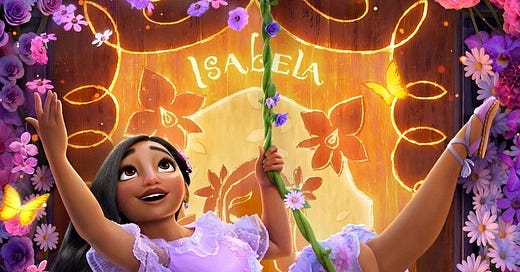Why every gardener needs to watch Disney's Encanto
Seriously: this one song captures the essence of what gardening is – or should be – all about
You’re reading The Earthworm, a brand new newsletter that takes a sideways look at the world of gardens, gardening, horticulture and all that good green stuff. If this is your first time here, please subscribe and join the community.
Have you seen Encanto? I have, on four occasions, at time of writing. Our household (two adults, one toddler) is also partly responsible for three of the animated musical’s songs currently occupying places in the official chart’s Top 10, including ‘We Don’t Talk About Bruno’ – the first original Disney song ever to reach the number 1 spot in the UK.
In case you haven’t seen Encanto – it’s currently available to stream on Disney+ – a quick summary: the film is set in tropical, colourful Colombia and follows Mirabel Madrigal, the most charming Disney protagonist I can remember. Each member of the Madrigal family has been blessed with a “gift” – basically a super power. Apart from Mirabel, that is, who is still coming to terms with being the least special member of a very special family. Or is she…?! Cue much singing and dancing and personal growth and overcoming of adversity. You know: Disney.
Is it a “good” film? I’m not entirely sure. The plot, such as there is one, maybe isn’t the most compelling – is some unknown force threatening the family’s miraculous gifts? Oh no! – but still Encanto, for me, is one of the most joyful and colourful and emotional cinematic experiences I’ve had in a long long time. Plot aside, the film delightfully captures the life-affirming spirit of Latin America (my mother’s motherland), and the music by Lin-Manuel Miranda (of Hamilton fame) is the rainbow icing on the celebration cake.
But what does any of this have to do with gardening?
Enter Mirabel’s elder sister, Isabela, whose gift is the power to conjure beautiful flowers out of thin air. See her here, with a flourish of her hand, framing the family home with blooming bougainvillaea; or there, filling a courtyard with wreaths of perfect pink roses; or gracefully swinging on a seat of hanging vines of her own creation. Beautiful Isabela floats through life with ease and elegance, and Mirabel hates her for it.
And so do I. Isabela’s floral arrangements are flawless. The colour combinations are divine, the blooms full and fragrant. If Isabela had an Instagram account, it would have many millions of followers, their hearts burning with envy. I would be one of them. I mean, if she’s always handling roses, how come her forearms aren’t constantly covered in scratches? Where are her grazed knees and calloused palms, from an afternoon spent on all fours, picking weeds out of the patio brickwork with a blunt table knife? And not once do we see her calling a plumber out because turns out that washing her mud-matted gardening gloves in the kitchen sink has inadvertently caused a foul-smelling blockage. Again.
Isabela’s gardening fills me with the same sense of jealous inadequacy that I feel when I watch Monty Don drifting through Long Meadow, or when I turn the pages of any number of garden magazines, or lose entire chunks of my day scrolling through the social media accounts of smiling, sun-kissed gardening influencers, their noses pressed daintily against the intricate folds of a Rosa ‘Gertrude Jekyll’ in fullest bloom.
My garden did not emerge from an effortless twirl of my fingers, but from year after year of back-bruising toil. And it still looks rubbish. Everywhere I look, I see jobs to be done. An unpulled weed whose root, anchored slapbang in the middle of the lawn, will now be thicker than my neck. A climbing vine with nothing to cling to, drooping clumsily from a rickety fence. A young hellebore suffocating under a blue plastic bag blown over the fence from a neighbouring garden.
Creating a lovely garden – sorry, trying to create a lovely garden – is so hard, I actually spend much of my time finding it stressful. That is not the feeling, we are told, that gardening is supposed to elicit from the gardener, which must mean I’m doing it wrong, which makes me feel even more depressed about my Sisyphean struggle to create something beautiful – not even beautiful, just nice – in an outdoor space smaller than my bedroom.
But then, something remarkable happens. (In Encanto, that is, not in my garden. Definitely not in my garden.) Following a tense and calamitous family dinner, Mirabel confronts her sister, offloading years of resentment. Mirabel, remember, has no “gift”. She is the odd one out, the ugly duckling. And here’s practically perfect Isabela sulking in her bedroom, demanding that Mirabel apologise to her.
Now, I don’t want to give away any spoilers, but I sort of have to here. Also, it’s not really a spoiler, as it has little to do with plot and more with character development. But anyway, SPOILER ALERT: It turns out that Isabela is miserable! Has been all along! She feels crushed by the expectation that she act perfect, look pretty and smell like roses at all times. What’s more, she is being forced to marry a man for whom she has no feelings. She screams: “I've been stuck being perfect my whole entire life!”
And with this uncharacteristic outburst of honest emotion, something strange happens: a cactus appears. Which, as we know, is all the excuse a Disney character requires in order to burst into spontaneous song. “I just made something unexpected / Something sharp, something new,” she begins. “It's not symmetrical or perfect / But it's beautiful… and it's mine.”
The rest of the song, called ‘What Else Can I Do?’ and linked to below, is a rousing rollercoaster of realisation. Gone are the “rows and rows of roses” and the “flor de mayo, by the mile”, replaced instead by strangler figs, a river of carnivorous sundews, a hurricane of jacaranda. Strange shapes and clashing colours erupt from every corner. Visually, it is a stunning sequence. Emotionally, even more so.
I am not exaggerating when I say that I am now unable to sit through this video without welling up. Partly, this is down to the fact that, since becoming a father a little over two years ago, I find myself a sleep-deprived emotional wreck with newly overactive tear ducts. But mainly, it is because of the sentiment that beauty can mean different things to different people; that happiness, contentment, comes when we stop trying to be who other people want or expect us to be, and focus on what, and who, we want to be.
And as someone who tends to a garden, it really resonates. I spend my summers fretting about whether this pinkish Dahlia ‘Bishop of Leicester’ clashes with this deep-purple Salvia ‘Amistad’ clashes with this canna and its ruby-red flower spike, and what this chronic inability to ‘get it right’ says about me as a gardener, nay, as a person. Which is why the unabashed wildness that ‘What Else Can I Do?’ promotes, that it celebrates, strikes a chord. Of course, perfect is impossible. And beautiful doesn’t have to mean pretty.
I look out of the window. Who is this garden for? For my family, I guess. For me, if I’m really honest. So why should it matter that it often looks so bedraggled, unkempt, impenetrable? Why should I care what a visitor, or reader (sorry!) thinks of it? In the words of Isabela Madrigal, “It's not symmetrical or perfect / But it's beautiful… and it's mine.” And you know what, that’s good enough for me.
As seen in Encanto
These plants – championed in the song ‘What Else Can I Do?’ – may not be deemed pretty by traditional measures, but they are nonetheless spectacular. According to Isabela Madrigal, and also me.
Strangler fig: Not technically a specific plant, but a category of plants (mainly Ficus) that, as the name so evocatively suggests, can entwine themselves around the trunks of host trees so thickly and so tightly that the host often dies.
Sundew (Drosera): As seen on TV! If you watched the mesmerising ‘Water Worlds’ episode of the BBC’s recent The Green Planet series, then you’ll have seen some of these invertebrate-gobbling carnivores doing their gruesome business.
Palma de cera, aka the Quindío wax palm (Ceroxylon quindiuense): The world’s tallest palm! In fact, it’s the world’s tallest monocot (one for the botany heads, there).
Have you seen Encanto? Did this song speak to you too? I’d love to know!
This week on The Earthworm
Yesterday: An introduction to me and my relationship with gardening. Catch up here.
Thursday: The 5 gardening mistakes I vow never to make again.
Friday: My interview with the one and only Jo Thompson – Chelsea Flower Show multiple gold medal-winner and one of the most influential (and nicest!) garden designers around.






Dan I’m intrigued - having avoided it, it’s now on my list to watch….